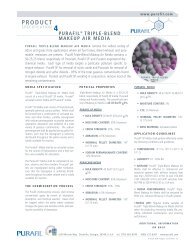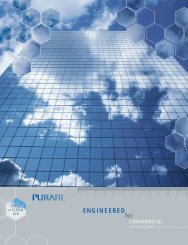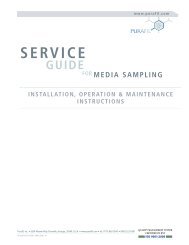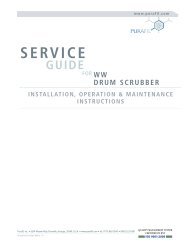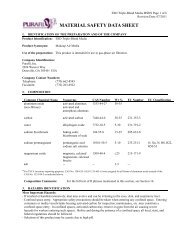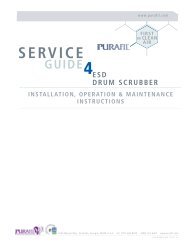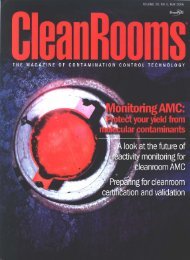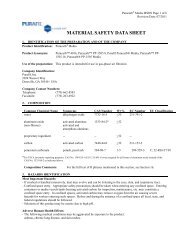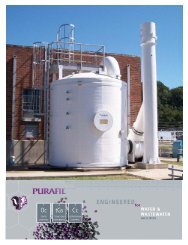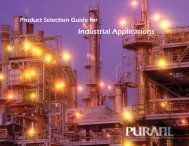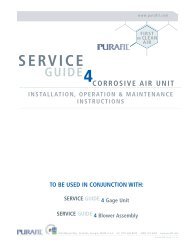case study - Purafil
case study - Purafil
case study - Purafil
Create successful ePaper yourself
Turn your PDF publications into a flip-book with our unique Google optimized e-Paper software.
CASE STUDY FOR<br />
THE SILVAN<br />
DISINFECTION PLANT<br />
PURAFIL ®<br />
FIRST<br />
IN CLEAN<br />
AIR<br />
www.purafil.com<br />
PURAFIL ESD PREVENTS<br />
ACCIDENTAL CHLORINE RELEASES<br />
FOR THE SILVAN DISINFECTION PLANT<br />
ABOUT THE SILVAN DISINFECTION PLANT<br />
Located in the mountains outside Melbourne, the Silvan Disinfection Plant was classified<br />
under state government legislation as a major hazard facility.<br />
THE PROBLEM<br />
According to plant project manager Stephen Answerth,<br />
"Melbourne Water was required to reduce the risk of a chlorine<br />
release ‘so far as practicable.'"<br />
Plant representatives considered using wet scrubbers, which<br />
were less expensive but required more maintenance and could<br />
harm humans, wildlife, and the environment.<br />
PURAFIL PROVIDES THE SOLUTION<br />
To prevent accidental chlorine (Cl 2 ) releases, Silvan opted to use<br />
a <strong>Purafil</strong> Emergency Gas Scrubber (EGS) that measured 10 feet<br />
in diameter by 15 feet tall and held 25,000 pounds of CSO<br />
media. Local <strong>Purafil</strong> representative James McIntosh (Airepure<br />
Australia) facilitated their request.<br />
In the event of an unintentional Cl 2 emission, the EGS follows<br />
these steps to eliminate the gas from the air:<br />
1) Released Cl 2 is drawn into the scrubber through a blower and<br />
contacts dry-scrubbing media.<br />
2) Media react with Cl 2 and permanently convert the gas to<br />
non-toxic solids.<br />
3) Clean air is discharged to the outdoors with a Cl 2 concentration<br />
of less than 5 parts per billion.<br />
The EGS requires significantly less maintenance than a wet<br />
scrubber. It does not need heaters for outdoor applications,<br />
and it has just one moving part--a blower. Instead of using liquid<br />
caustic, the EGS neutralizes Cl 2 with dry-scrubbing media,<br />
which are highly porous, spherical pellets that permanently<br />
transform the gas into harmless solids. As long as media do not<br />
react with Cl 2 , they do not need to be replaced; they only<br />
require occasional testing to determine remaining life and to<br />
project change-out dates. Non-toxic and non-hazardous,<br />
media do not require special handling and can be disposed in<br />
landfills.<br />
"The dry scrubber was selected because it is a simpler system<br />
and does not involve having liquid caustic soda on-site,"<br />
Answerth said.<br />
ABOUT PURAFIL ESD<br />
For more than 15 years, <strong>Purafil</strong> ESD has been the premier single-source<br />
provider of clean air to over 100 North American<br />
and European clients. A division of <strong>Purafil</strong>, Inc., <strong>Purafil</strong> ESD<br />
manufactures a broad range of dry-scrubbing media and systems<br />
that remove odorous, toxic, and corrosive gases at water<br />
and wastewater applications.<br />
<strong>Purafil</strong> ESD's Emergency Gas Scrubber (EGS) removes the contents<br />
of a fully-loaded chlorine (Cl 2 ) or sulfur dioxide (SO 2 )<br />
cylinder in a worst-<strong>case</strong> release scenario and discharges less<br />
than 5 parts per billion. The EGS works in temperatures ranging<br />
from -40 degrees to 200 degrees Fahrenheit.<br />
In the event of a release, the EGS draws Cl 2 /SO 2 -laden air<br />
through a bed of dry-scrubbing media. The gases react irreversibly<br />
with the media's chemical impregnant, and the products<br />
of this reaction are solid salts that can be disposed of in<br />
common landfills.<br />
PURAFIL ® EMERGENCY GAS SCRUBBER<br />
<strong>Purafil</strong>, Inc. • 2654 Weaver Way, Doraville, Georgia, 30340, U.S.A. • www.purafil.com • tel: (770) 662-8545 • (800) 222-6367<br />
© <strong>Purafil</strong> 2006 CsStdy--Silvan-01<br />
ISO 9001:2008
CASE STUDY<br />
FOR<br />
T H E D E T R O I T WAT E R<br />
T R E AT M E N T P L A N T<br />
FIRST<br />
IN CLEAN<br />
AIR<br />
A B O U T T H E S P R I N G S W E L L S W A T E R T R E A T M E N T P L A N T<br />
P U R A F I L<br />
P R E V E N T S AC C I D E N TA L<br />
C H L O R I N E R E L E A S E S<br />
FOR THE DETROIT WATER<br />
TREATMENT PLANT<br />
Springwells Water Treatment Plant is a 540 million gallon per day (mgd) surface water<br />
treatment plant located in a mixed residential and light industrial area on the west side of<br />
Detroit. The largest freshwater treatment plant in Michigan, Springwells draws water from<br />
the Detroit River, disinfects it with chlorine, coagulates it with alum, and filters it through<br />
high-rate dual-media rapid sand filters. Plant output feeds a distribution system serving<br />
approximately 125 communities and 4.3 million consumers. Built in 1931, the original plant<br />
was a combined treatment plant and pumping station of 340 mgd capacity. An additional<br />
200 mgd capacity was added in 1958 for a total design capacity of 540 mgd.<br />
T H E P R O B L E M<br />
Because source waters are low in organic content,<br />
Springwells disinfects the water with liquid chlorine,<br />
which is stored in one-ton containers. The plant<br />
previously used a sodium hydroxide wet-scrubbing<br />
system to neutralize chlorine gas in the event of an<br />
accidental release. However, this system contained<br />
a messy, highly corrosive lye solution that was<br />
hazardous to system operators and attacked piping,<br />
valves, and pump seals. Keeping the wet scrubber<br />
operational required extensive maintenance, and the<br />
system ultimately fell into disrepair, with only the<br />
fans working in its last days.<br />
P U R A F I L P R O V I D E S T H E S O L U T I O N<br />
When Springwells replaced their entire chlorine<br />
storage and feed facility, they purchased a <strong>Purafil</strong><br />
Emergency Gas Scrubber (EGS) from local<br />
representative Ryan Forbes (Hi-Tech Environments).<br />
The EGS "dwarfed the former wet scrubbing<br />
system," said Richard Pernal, filtration supervisor.<br />
"With nearly a tenfold increase in storage and feed<br />
capacity, special emphasis was given to reliability<br />
and safety. A sister plant in our system had<br />
upgraded to a <strong>Purafil</strong> dry scrubber earlier with<br />
favorable results. With our system upgrade, the<br />
same <strong>Purafil</strong> scrubber was specified."<br />
The EGS requires significantly less maintenance than<br />
a wet scrubber. It does not need heaters for<br />
outdoor applications, and it has just one moving<br />
part – a blower. Instead of using liquid caustic, the<br />
EGS neutralizes chlorine with dry-scrubbing media,<br />
which are highly porous, spherical pellets that<br />
permanently transform the gas into harmless solids.<br />
As long as media do not react with chlorine, they do<br />
not need to be replaced; they only require<br />
occasional testing to determine remaining life and<br />
to project change-out dates. Non-toxic and nonhazardous,<br />
media do not require special handling<br />
and can be disposed in landfills.<br />
According to Pernal, "The <strong>Purafil</strong> EGS has been<br />
especially trouble free. There are no corrosive<br />
liquids to handle, no valves to foul, no spills to<br />
contain. The scrubber's operation is checked on a<br />
weekly basis by testing our chlorine detectors with<br />
a calibration gas. Our local <strong>Purafil</strong> representative<br />
periodically visits to sample the dry-scrubbing<br />
media for analysis."<br />
Pernal has nothing but praise for the dry scrubber.<br />
"Our system looks and performs today as well as<br />
day one, with virtually no maintenance. The<br />
maintenance savings are great, and operations has<br />
a system that is not dangerous to operate. We're<br />
very happy with our EGS."<br />
<strong>Purafil</strong>, Inc. • 2654 Weaver Way, Doraville, Georgia, 30340, U.S.A. • www.purafil.com • tel: (770) 662-8545 • (800) 222-6367<br />
© <strong>Purafil</strong> 2007 CsStdy--Detroit WWTP-01<br />
ISO 9001:2008
A B O U T T H E E G S<br />
P U R A F I L D R Y- S C R U B B I N G M E D I A<br />
<strong>Purafil</strong>'s Emergency Gas Scrubber (EGS) removes the<br />
contents of a fullyloaded<br />
chlorine (Cl 2 ) or<br />
sulfur dioxide (SO 2 )<br />
cylinder in a worst-<strong>case</strong><br />
release scenario and<br />
discharges less than 5<br />
parts per billion. The<br />
EGS works in<br />
temperatures ranging<br />
PURAFIL<br />
from -40 degrees to 200<br />
® CHLOROSORB MEDIA<br />
degrees Fahrenheit.<br />
In the event of a release, the EGS draws Cl 2 /SO 2 -laden<br />
air through a bed of dry-scrubbing media. The gases<br />
react irreversibly with the media's chemical impregnant,<br />
and the products of this reaction are solid salts that can<br />
be disposed in common landfills.<br />
· System media are UL Classified.<br />
· System media are immediately available for instantaneous reaction.<br />
· Spent media are landfill acceptable before and after use.<br />
A B O U T P U R A F I L<br />
For over 40 years, <strong>Purafil</strong>’s gas-phase media has protected<br />
environments from corrosive, toxic, irritant and odorous gases. <strong>Purafil</strong>,<br />
Inc. is the world leader in innovating, designing, engineering, and<br />
manufacturing gas-phase air filtration systems, atmospheric and<br />
reactivity corrosion monitors, and UL classified granular media. <strong>Purafil</strong><br />
maintains nearly 40,000 global installations in industrial, commercial,<br />
municipal, high purity, mission critical (data centers and server rooms),<br />
power generation, and preservation facilities.<br />
Call <strong>Purafil</strong> at 1-800-222-6367 for assistance with your air quality<br />
concerns or visit our Web site at www.purafil.com.<br />
<strong>Purafil</strong>, Inc. • 2654 Weaver Way, Doraville, Georgia, 30340, U.S.A. • www.purafil.com • tel: (770) 662-8545 • (800) 222-6367<br />
© <strong>Purafil</strong> 2007 CsStdy--Detroit WWTP-01<br />
ISO 9001:2008
CASE STUDY FOR<br />
THE CITY OF RICHLAND’S COLUMBIA<br />
RIVER WATER TREATMENT PLANT<br />
PURAFIL ®<br />
FIRST<br />
IN CLEAN<br />
AIR<br />
www.purafil.com<br />
PURAFIL PERFORMS SUCCESSFUL RETROFIT<br />
FOR THE CITY OF RICHLAND’S<br />
WATER TREATMENT PLANT<br />
ABOUT THE CITY OF RICHLAND WATER TREATMENT PLANT<br />
The City of Richland’s Columbia River Water Treatment Plant (WTP) was built and put into operation in the fall of 1963, supplementing<br />
a system of wells that were constructed by the Federal government in the 1940’s. Richland’s WTP is a direct filtration surface water<br />
treatment plant designed to treat a maximum flow of 30 million gallons a day. The plant is one of three water treatment sites operated<br />
and maintained by Richland Water. The system presently serves a population of approximately 50,000. The WTP handles surface water<br />
in a series of treatment processes, including coagulation, chlorination, and filtration. Chlorine disinfection may occur both before and<br />
after filtration depending on the surface water conditions. Chlorine usage during the summer months can exceed 500 pounds per day.<br />
THE PROBLEM<br />
In 1996, the WTP went through a plant expansion that<br />
doubled the rated capacity from 15 mgd to 30 mgd. The<br />
renovation included construction of a chlorine handling<br />
facility and the installation of a wet chlorine scrubber<br />
with a designated emergency generator. The emergency<br />
scrubber developed leakage problems and ended up<br />
being drained and shipped out for repairs twice in a<br />
four-year period. Caustic wet scrubbers use large<br />
amounts of chemicals to operate and also require much<br />
more maintenance than dry scrubbers; and because<br />
they use harsh chemicals, they are also subject to very<br />
strict guidelines. The plant operators also noticed<br />
caustic freezing issues that would render the scrubber<br />
inoperable during very cold periods of the winter<br />
months.<br />
Crystallized caustic found in the wet scrubber during the retrofit<br />
In 2006, Richland Water completed construction of a<br />
new multiple phase Ultraviolet Disinfection Facility<br />
(UVDF). This facility was designed to use chlorine for<br />
contact time and residual detection to ensure<br />
maximum disinfection. Since the disinfection facility<br />
was storing large amounts of chlorine, they decided to<br />
invest in a more efficient emergency standby<br />
equipment to prevent accidental chemical releases.<br />
Based on their previous experience with wet scrubbers,<br />
Richland Water incorporated a <strong>Purafil</strong> dry Emergency<br />
Gas Scrubber (EGS) to the UVDF. Seeing the benefits of<br />
using <strong>Purafil</strong>’s EGS, Richland Water decided to replace<br />
the failing wet scrubber at the WTP with a dry scrubber.<br />
PURAFIL PROVIDES THE SOLUTION<br />
At first, the city considered switching the<br />
wet scrubber to a brand new <strong>Purafil</strong><br />
dry 1-ton capacity scrubber.<br />
When the plant operators<br />
contacted <strong>Purafil</strong>’s local<br />
representative, Treatment<br />
Equipment Company, they<br />
learned about the capability to<br />
retrofit existing wet chlorine<br />
scrubbers to dry scrubbers using<br />
Chlorosorb ® Ultra Media.<br />
<strong>Purafil</strong> Water-Wastewater Market Manager, Colin<br />
Christie, provided a competitive quote to complete the<br />
retrofit. Due to the significant cost savings and the<br />
capabilities of Richland Water’s staff to perform the<br />
work in-house, the plant managers decided to turn<br />
their existing installation into an efficient, low<br />
maintenance dry scrubbing system. <strong>Purafil</strong> project<br />
engineers worked closely with the WTP staff to make<br />
the retrofit a success.<br />
Chlorosorb ® Ultra Media<br />
<strong>Purafil</strong>, Inc. • 2654 Weaver Way, Doraville, Georgia, 30340, U.S.A. • www.purafil.com • tel: (770) 662-8545 • (800) 222-6367<br />
© <strong>Purafil</strong> 2012 CsStdy--RLD- 01<br />
ISO 9001:2008
CUSTOMER SATISFACTION<br />
Richland Water’s staff was able to perform all the<br />
required labor. With the guidance of <strong>Purafil</strong>’s project<br />
engineers, all questions and issues regarding the<br />
project were dealt with in a timely manner. Thanks to<br />
the support and efforts of <strong>Purafil</strong> and its<br />
representatives, the project was completed on time and<br />
under budget. Based on the approved budgeted<br />
amount for the project, Richland Water saved<br />
approximately $70,000 by retrofitting its existing<br />
installation using <strong>Purafil</strong>’s expertise.<br />
Richland WTP’s Water Manager, John Finch, told <strong>Purafil</strong>,<br />
“Having owned and operated two different types<br />
of scrubbers, I know for a fact that the <strong>Purafil</strong> dry<br />
scrubber is much easier to operate and maintain.”<br />
Retrofitted scrubber at the water treatment plant<br />
Thanks to its successful retrofit, Richland water<br />
treatment plants are currently only using dry scrubbers.<br />
DRY SCRUBBERS VERSUS WET SCRUBBERS<br />
Dry scrubbers have several advantages over<br />
conventional wet scrubbers. For instance, dry scrubbers<br />
require significantly less maintenance than wet<br />
scrubbers. They have just one moving part—a blower.<br />
No need to hassle with pumps, spray nozzles, or pH<br />
controls!<br />
Dry scrubbers are much<br />
safer, too. Instead of<br />
using toxic caustic liquid,<br />
they neutralize gases<br />
with non-toxic dryscrubbing<br />
pellets. These<br />
pellets are called media,<br />
and they permanently<br />
transform gases into<br />
harmless solids. Unlike<br />
caustic liquid scrubbers<br />
which require staff to <strong>Purafil</strong> Emergency Gas Scrubber<br />
regurlarly measure the<br />
total amount of gas that can be fed in the scrubber, the<br />
media inside dry scrubbers are immediately available<br />
for instantaneous reaction, regardless of the gas load<br />
rate.<br />
<strong>Purafil</strong>’s dry emergency gas scrubber discharges less<br />
than 25 parts per billion, whereas wet scrubbers<br />
discharge 1-4 parts per million.<br />
PURAFIL’S PATENTED RETROFIT PLAN FOR<br />
WET TO DRY CONVERSION IS AS EASY AS 1, 2, 3!<br />
STEP 1:<br />
Remove Caustic Material<br />
Remove the three-panel lid.<br />
Drain and dispose of liquid caustic from reservoir and reaction chamber.<br />
Remove recirculation pump and pipe.<br />
STEP 2:<br />
Modify Existing Scrubber<br />
STEP 3:<br />
Install <strong>Purafil</strong> Chlorosorb ® Ultra Media<br />
Remove and dispose of tower packing material.<br />
Cut out internal fiberglass walls and barrier between reaction chamber and liquid reservoir.<br />
Install aluminum posts and secure to external fiberglass walls.<br />
Install perforated, aluminum media screens and secure to posts.<br />
Install <strong>Purafil</strong> ESD Chlorosorb Ultra dry chemical media between media screens.<br />
Replace three-panel lid and plug holes.<br />
<strong>Purafil</strong>, Inc. • 2654 Weaver Way, Doraville, Georgia, 30340, U.S.A. • www.purafil.com • tel: (770) 662-8545 • (800) 222-6367<br />
© <strong>Purafil</strong> 2012 CsStdy--RLD - 01<br />
ISO 9001:2008
CASE STUDY FOR<br />
MOCCASIN BEND WASTEWATER<br />
TREATMENT PLANT<br />
PURAFIL ®<br />
FIRST<br />
IN CLEAN<br />
AIR<br />
www.purafil.com<br />
PURAFIL EGS PREVENTS TOXIC<br />
CHLORINE GAS RELEASE<br />
FOR THE CITY OF CHATTANOOGA<br />
MOCCASIN BEND WWTP CUSTOMER SATISFACTION<br />
“We installed a <strong>Purafil</strong> [emergency chlorine] gas scrubber in 2000 [to comply with] our risk management plan,” explains<br />
Jerry Stewart, City Director of Waste Resources for the City of Chattanooga which oversees Moccasin Bend Wastewater<br />
Treatment Plant (WWTP). “It’s been nine years and we never had to use it. The day finally came and it performed as<br />
advertised.”<br />
As a plant operator attempted to switch the chlorine cylinders, a potentially catastrophic chlorine leak occurred. Although<br />
the plant operator escaped the chlorine leak and did not sustain injury, the WWTP implemented its emergency response<br />
plan; the Chattanooga Fire Department hazardous waste unit responded to the site; an Incident Command Structure was<br />
established; and the plant site and surrounding areas were secured; and the local chlorine supplier’s emergency response<br />
team was called to access and shut off the leaking one-ton chlorine cylinder Fortunately, the risk was minimal; and Stewart<br />
reported, the plant’s emergency gas scrubber “neutralized all of the chlorine that leaked out of the one-ton cylinder.”<br />
THE PROBLEM<br />
Wastewater treatment plants combine four primary steps<br />
to process sewage: liquid handling, solid handling, pump<br />
stations and plant maintenance. During the liquid<br />
handling process, chlorine (Cl 2 ) is used to treat the<br />
cleaned wastewater.<br />
Facilities storing large quantities of chlorine, typically in<br />
one or more one-ton cylinders, must invest in emergency<br />
standby equipment to prevent accidental chemical<br />
releases. The U.S. Environmental Protection Agency’s<br />
(EPA) Risk Management Program for Chemical Accident<br />
Release Prevention “requires regulated facilities to<br />
develop and implement appropriate risk management<br />
programs to minimize the frequency and severity of<br />
chemical plant accidents.” In addition, “a performancebased<br />
approach towards compliance with the risk<br />
management program rule is required.”<br />
If a toxic gas release from a one-ton cylinder were to<br />
occur, the thermodynamic properties of chlorine suggest<br />
that approximately 400 lbs of liquid chlorine would flash<br />
into vapor and the remaining contents of the cylinder<br />
would spill out as a liquid at its boiling point. According<br />
to the American Water Works Association (AWWA) Risk<br />
Management Program (RMP) Guidance, the outer limit of<br />
the impact area, in a chlorine release, is drawn at a fivemile<br />
radius in all directions from the point of impact.<br />
EGS is designed to neutralize an initial 400 lbs in the first<br />
minute and any additional chlorine at a rate of 80<br />
lbs/min thereafter, which exceeds the requirements of the<br />
Uniform Fire Code.<br />
Instead of using toxic, liquid caustic to neutralize gases,<br />
the EGS uses non-toxic, dry-scrubbing medium. This<br />
medium’s chemisorptive process removes chlorine by<br />
means of adsorption, absorption and chemical reaction.<br />
Chlorine gas is trapped within the medium pellet where<br />
an irreversible chemical reaction changes the chlorine<br />
gas into a harmless solid.<br />
During the chlorine leak at Moccasin Bend, <strong>Purafil</strong> ESD’s<br />
EGS immediately began to disinfect the chlorine gas,<br />
minimizing the risk to the worker and the community.<br />
Gary Williams, Occupational Safety Specialist admits, “It’s<br />
an emotional thing when you think that someone could<br />
have died.”<br />
This unit and site are prime examples of the benefits of<br />
PURAFIL PROVIDES THE SOLUTION<br />
In 2000, Moccasin Bend officials purchased a <strong>Purafil</strong> ESD<br />
FOC-1, fiberglass EGS with Chlorosorb ® dry-scrubbing<br />
medium and installed it adjacent to the chlorination<br />
room. <strong>Purafil</strong> ESD’s dry-chemical EGS is designed to<br />
contain the entire contents of a fully loaded 1-ton<br />
chlorine cylinder in a worst-<strong>case</strong> release scenario. The<br />
PURAFIL ® ESD FIBERGLASS ONE-TON (FOC-1)<br />
EMERGENCY GAS SCRUBBER (EGS)<br />
PURAFIL ® ESD CHLOROSORB ® ULTRA DRY-<br />
SCRUBBING MEDIA<br />
<strong>Purafil</strong>, Inc. • 2654 Weaver Way, Doraville, Georgia, 30340, U.S.A. • www.purafil.com • tel: (770) 662-8545 • (800) 222-6367<br />
© <strong>Purafil</strong> 2009 CsStdy--Moccasin Bend-01<br />
ISO 9001:2008
an EGS with dry-scrubbing media. The dry-scrubbing<br />
medium within the<br />
unit is non-toxic,<br />
non-hazardous,<br />
maintenance-free,<br />
UL Classified, and<br />
most importantly, it<br />
can effectively help<br />
to save the priceless<br />
elements of a<br />
community. Stewart<br />
contends, “The<br />
biggest thing [the<br />
EGS] did for us was<br />
turn a [potentially]<br />
CHLORINE TANKS WITHIN MOCCASIN BEND WWTP’S<br />
CHLORINE ROOM<br />
major chlorine incident into a minor one. We were able<br />
to shut the gas off without it escaping to surrounding<br />
areas.”<br />
For years, Moccasin Bend WWTP’s officials have<br />
underscored safety. The chlorine room’s sensors were<br />
installed to measure a leak of 1 part per million (ppm),<br />
which will activate an alarm and seal the building to<br />
contain the gas. These preventative measures are vital to<br />
guard against a worst-<strong>case</strong> scenario leak. In 2004,<br />
Moccasin Bend professionals also conducted the largest<br />
regional chlorine drill with the Chattanooga Fire<br />
Department to enact proper procedures during a<br />
simulated leak.<br />
<strong>Purafil</strong> is proud to have played an integral role in<br />
protecting the Moccasin Bend community. The EGS filled<br />
with the original Chlorosorb medium remained<br />
unchallenged for nearly 10 years. When the leak<br />
occurred, it performed as specified without any<br />
evidence of medium degradation due to age or<br />
environmental conditions. When the “all clear”<br />
signal was given and the Chlorosorb in the EGS<br />
was removed, all indications were that the unit<br />
performed properly and it successfully withstood<br />
the toxic exposure. Moccasin Bend WWTP recently<br />
ordered 23,000 pounds of new Chlorosorb Ultra<br />
media, which has a minimum removal capacity of<br />
15% by weight and the capacity to remove up to<br />
3450 pounds of chlorine.<br />
National Historic Landmark and a Native American Burial<br />
Ground.<br />
According to The Friends of Moccasin Bend National Park,<br />
a nonprofit organization, the area represents the<br />
historical Native essence of Chattanooga. Its place in<br />
history, which predates the Common Era, has been<br />
chronicled with life and its necessity for potable water.<br />
Subsequently, the wastewater treatment plant was built<br />
in the 1960s and bears the same name. Moccasin WWTP<br />
serves 250,000 people, treats 140 million gallons of<br />
water per day (MGD) and has a maximum hydraulic<br />
capacity of 220 MGD.<br />
ABOUT PURAFIL ESD<br />
<strong>Purafil</strong> ESD’s EGSs are more advantageous than toxic,<br />
liquid wet scrubbers. <strong>Purafil</strong> introduced an easy Retrofit<br />
Plan for Liquid Caustic Scrubbers transform wet scrubbers<br />
and protect wastewater facilities and their communities<br />
from potential risk.<br />
<strong>Purafil</strong> ESD is the premier single-source manufacturer of<br />
clean air products throughout North America and Europe.<br />
A division of <strong>Purafil</strong>, Inc., <strong>Purafil</strong> ESD manufactures a<br />
broad range of dry-chemical media and scrubbers that<br />
remove odors, prevent toxic gas releases, and corrosion of<br />
electronics.<br />
Call <strong>Purafil</strong> ESD at 1-800-222-6367 for assistance with<br />
your air quality concerns or visit our Web site at<br />
www.purafil.com.<br />
MEDIA LIFE ANALYSIS AFTER RELEASE<br />
ABOUT THE SITE<br />
The Tennessee River and Cumberland Escarpment<br />
intersect to form the historical Moccasin Bend in<br />
Chattanooga. The 925-acre area’s significant<br />
development and relevance for its original Native<br />
American inhabitants span more than 10,000 years.<br />
In fact, residents and historians, alike, have lobbied<br />
to preserve Moccasin Bend for more than 20 years.<br />
In turn, the plush grounds nestled within the<br />
Chickamauga and Chattanooga National Military<br />
parks have also been deemed an Archaeological District<br />
among the National Register of Historic Places, a<br />
PURAFIL ENGINEERS DESIGN SYSTEMS TO HANDLE MORE THAN A ONE-TON CHLORINE RELEASE.<br />
FIELD ANALYSIS SHOWS THAT AFTER THE RELEASE IT STILL HAS OVER 10% LIFE REMAINING.<br />
THE MEDIA LIFE ANALYSIS (MLA) SHOWN ABOVE DEPICTS THE PURAFIL CHLOROSORB MEDIA<br />
AFTER THE RELEASE WITHIN THE FOC-1 UNIT LOCATED AT THE MOCCASIN BEND WWTP, WHICH<br />
GENERATES 5,000 CFM.<br />
<strong>Purafil</strong>, Inc. • 2654 Weaver Way, Doraville, Georgia, 30340, U.S.A. • www.purafil.com • tel: (770) 662-8545 • (800) 222-6367<br />
© <strong>Purafil</strong> 2009 CsStdy--Moccasin Bend-01<br />
ISO 9001:2008



